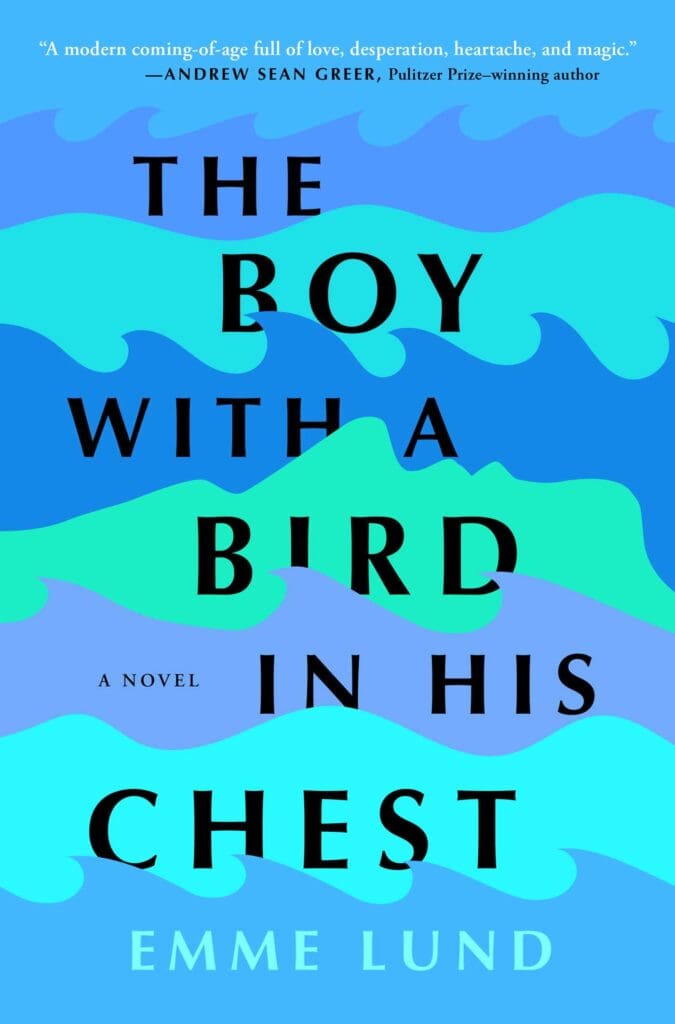The last few years have seen queer and trans literature receive a long-overdue upswing in both publication and attention. Emme Lund’s first novel, The Boy with a Bird in His Chest (320 pages; Atria Books), takes a well-earned place among its siblings, while shimmering brightly with its own unique brilliance.
Lund’s lyrical and fabulist-leaning tale is the story of Owen Tanner, a boy with a java sparrow living in a hole behind his ribs. Born during the worst spring flood in Morning, Montana, Owen is supposed to be lucky. Yet the beginning of his life seems anything but. According to the medical establishment, the bird in his chest makes him a Terror. Although Owen’s mother manages to keep her son out of the clutches of what she calls the Army of Acronyms, the boy is consigned to ten years locked indoors, for fear that someone might identify him for what he is.
Like in many a good bildungsroman, Owen’s journey begins when he makes a stubbornly foolish decision. He goes outside during a forest fire and is consequently discovered by a wolf of a doctor whose maniacal pursuit of an actual Terror forces Owen to go live with his uncle and cousin in Olympia, Washington. His mother dares not stay with him for fear of giving away his whereabouts and returns to Montana, only contacting her son sporadically to make sure the Army hasn’t gotten to him yet.
Despite the constant threat of danger, The Boy with a Bird in His Chest is a dreamy book, slow-moving at its start and laced with textured introspection. Lund’s language is poetically simple and clear, interspersed with a few foundational metaphors such as Owen’s pull toward water and his tendency to breathe through anxiety by imagining his roots going deep into the ground. In one passage, Owen feels himself as the entire Pacific:
For a moment, Owen heard only the distant ocean’s roar, its static buzz and hiss. He imagined the rhythm of it flooding the Sound, the waves pulling away from the coast of Asia and slamming against North America, and then sliding away from North America and roaring back towards Asia, a simple back-and-forth, a surging. […] The ocean burst inside him. With each set of waves that struck the Washington coast, a spurt of blood gushed from his nose. It tasted like seawater.
One can’t help but notice the novel’s relationship to fairytales in its depiction of an omnipresent sea, forest, and moon. And, like the best fables, the story doesn’t rest on the metaphoric significance of the bird named Gail in Owen’s chest. This conceit instead becomes a deeply felt experience for the characters, and thus for the reader. Lund deftly integrates magic with the mundane, creating a universe where Gail can trace a wing along Owen’s spine while he sits in a dingy high school stairwell.
Yes—Owen goes to high school. Part of his mother’s strategy in placing him with his uncle is to hide her son in plain sight. Surrounded by people for the first time, Owen struggles between his desire to connect with others and his inability to be his true bird-chested self, lest the Army of Acronyms capture him. Although Owen finds queer kinship with his cousin Tennessee and her community, he becomes a target of violence for bullies and for his neighbor Clyde’s father, “a man who took up space. The Army of Acronyms incarnate.” Despite these menaces and his mother’s traumatizing phone calls, Owen grows into himself. He discovers music, drugs, the joys of fashion, and even romance. Yet the all-important question never leaves him: how can Owen craft a life for himself in a world that believes he shouldn’t exist?
Owen’s love for his impossible companion Gail, and in turn Gail’s contentment with dwelling forever behind Owen’s ribs, are a crucial anchor for The Boy with a Bird in His Chest. By avoiding substantial friction between the two, Lund eschews the damaging dominance of the queer self-hatred trope. Although Gail’s existence makes Owen’s life tremendously difficult, he rarely lashes out at her, and eventually understands that “the bird in his chest, the thing that he wished weren’t there for so much of his life was actually the reason he was still alive.” Equally powerful is the support of Owen’s family. His mother and Tennessee are the only ones who know about Gail, and they both love her. His uncle regularly tells Owen he is a “good kid,” and accepts both his nephew and his daughter’s queerness. This allows Lund to turn the spotlight outward, highlighting the crushing effects of living in a society that vilifies the “other.” The persecution by the Army of Acronyms, “a long lineage of men taking whatever they wanted regardless of the consequences,” drives Owen to suicidal despair, a state which we learn about in the very first chapter and hovers ominously over the entire book.
Despite such heartbreaking elements, The Boy with a Bird in His Chest remains enchantingly hopeful. Lund has succeeded in creating a queer myth for a contemporary generation, although that doesn’t mean Owen’s story will only touch queer folks. At its heart, the novel is about finding belonging and love by finding oneself. While we may not have birds in our chests, who among us can’t relate to that quest?

